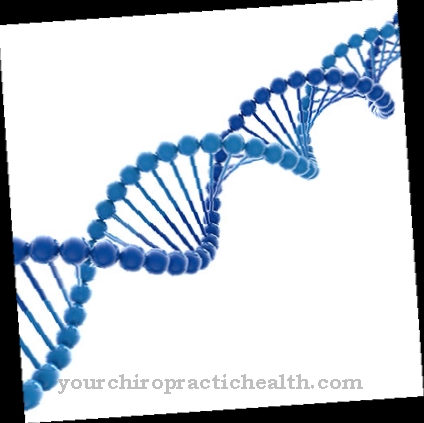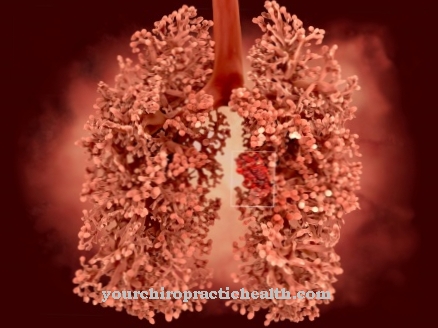Coats disease is a congenital disease of the eyes caused by a genetic defect. Coats' disease leads to complete blindness and can only be treated curatively to a limited extent.
What is Coats Disease?

© Henrie - stock.adobe.com
At Coats disease It is a rare congenital eye disease that affects boys far more often than girls. The retinal blood vessels are dilated and permeable so that blood and fluid from the eye can get under the retina.
This causes edema, which - if the disease remains untreated - leads to the detachment of the retina and ultimately to complete blindness.
Coats disease usually occurs on one side - a typical feature is a milky white film over the eye.
There is usually no pain. Sometimes glaucoma develops from an increase in intraocular pressure. Less than ten percent of those affected have no symptoms at all. In the long term, there is a general risk of total blindness with Coats' disease.
causes
The causes for Coats disease are currently unknown. Numerous studies in the family environment of those affected allow the conclusion that there is a hereditary predisposition to develop Coats' disease.
A retardation of the X chromosome is suspected. The cause of the blindness that Coats' disease usually leads to is the defective blood vessels in the eye. As a result of this defect, bulges (aneurysms) develop in the blood vessels of the retina, which lead to the blood vessels becoming porous and allowing fluids to escape.
The fluids (blood, cholesterol crystals, lipids) are deposited under the retina and later lead to a detachment of the retina. As a result, the patient's eyesight will deteriorate more and more and ultimately lead to blindness.
Symptoms, ailments & signs
The first symptoms of Coats disease usually appear in the first or second decade of life. Boys are affected much more often than girls. In addition, in over 90 percent of cases, it is a unilateral eye disease caused by aneurysms of the eye blood vessels. Secondary strabismus and leukocoria are usually observed as initial symptoms.
In leukocoria, the fundus of the eye does not appear red, as is usually the case, in photographs taken with flash, but white. Patients can often only see blurred in the affected eye. Spatial vision is impaired. However, the loss of vision in young children is often not noticed at first.
However, not every disease course is the same. The progression of the disease can come to a standstill temporarily or even permanently.
In a few cases an improvement in symptoms was even observed. In most cases, however, retinal detachment occurs, which then leads to blindness in the affected eye. The course of the disease is often much more intense in children under five than in older children. In severe cases, it may be necessary to remove the eyeball.
Diagnosis & course
If you suspect Coats disease - secondary strabismus may be the first, visible sign - the ophthalmologist will perform an ophthalmoscopy (examination of the fundus). To do this, the doctor illuminates the fundus of the eye and can use it to identify changed blood vessels. The examination is painless and only takes a few minutes.
Patients suffering from Coats' disease initially show a secondary squint; it is also particularly noticeable that eyes photographed with flash light do not appear red, but milky white. During this phase of the disease, the patient's spatial vision is limited and images are only perceived as blurred. The process is usually painless - the patient only feels pain in the eye when the intraocular pressure increases.
The rise in intraocular pressure can lead to glaucoma, a common disease that accompanies Coats' disease. In affected small children, the disease usually goes unnoticed because they do not notice the constant loss of their eyesight. Furthermore, the course is different for each patient - while most patients experience continuous deterioration, some patients report intermittent deterioration. In a few cases a regression could even be observed. As a rule, however, Coats disease leads to a complete detachment of the retina and thus to complete blindness.
Complications
Coats disease causes severe discomfort to the eyes and furthermore loss of vision. In the worst case, this can lead to complete blindness, which can usually no longer be cured. It is not uncommon for visual problems or blindness to lead to severe psychological impairments or to depression.
Those affected often suffer from inferiority complexes or from a reduced self-esteem. Dealing with vision loss is relatively difficult, especially for young people. Those affected can still squint and see only blurred. Veiled vision occurs and, in some cases, double vision occurs.
Furthermore, a glaucoma or a cataract can develop and the eyes have different eye colors. Complete blindness usually only occurs if the disease is not treated. The treatment itself can be done relatively easily and does not lead to particular complications.
The visual problems can thus be resolved and complete blindness can be prevented. There are no particular complications. Furthermore, the pain is also limited by the treatment. Coats disease does not lead to a reduction in life expectancy.
When should you go to the doctor?
A doctor is generally required if the eyesight is impaired. If the eyes are tilted or the pupils have other peculiarities, a doctor should be consulted. Broken blood vessels in the eyeball, reddening of the eyes and clouding of the cornea should be examined and treated by a doctor. Since Coats' disease is a genetic disease, an irregularity is found in many cases immediately after birth. The diagnosis can often be made shortly after the birth after the first examination. In a routine procedure, the newborn is examined intensively by the nurses, midwives or doctors present. The dysfunction of the eyes can therefore already be tested at this stage of life.
If parents notice abnormal eyesight in their children during the growth and development process, they should consult a doctor immediately. If there are more accidents in everyday life or if the toddler regularly reaches near objects, it needs medical help. If there is a suspicion that there is a complete inability to see, it is advisable to visit a doctor as soon as possible. If the child cries continuously, this can be an indication of pain or strong internal pressure in the eye. A doctor should be consulted so that treatment can be initiated.
Treatment & Therapy
Becomes Coats disease Detected early - i.e. before the retina is first detached - it can be treated well. The aim is to preserve some of the eyesight. An ophthalmologist can locate altered blood vessels and, in a subsequent step, use a laser to obliterate them.
In this phase of the disease, good treatment results can also be achieved with cold therapy. Both therapies prevent fluid from escaping and thus prevent the retina from becoming detached. If Coats disease is more advanced and the retina has already loosened, Coats disease can no longer be treated curatively. The doctor can only remove the affected part of the vitreous humor and / or the retina.
To rule out a malignant background - such as a retinoblastoma - it can be helpful to remove the eye completely. The eyesight cannot be restored after the detachment of the retina - the interventions described can only relieve intraocular pressure and thus reduce or completely eliminate pain in the eye.
You can find your medication here
➔ Medicines for visual disturbances and eye complaintsOutlook & forecast
Coats disease offers a relatively good prognosis. Usually only one eye is affected by the disease, which can be surgically removed. Those affected can then lead a normal, symptom-free life. However, Coats disease is at great risk of relapse. In the event of a relapse, the therapeutic measures must be repeated. Drug treatment of the pain is associated with side effects and interactions.
If left untreated, the disease progresses and leads to complete blindness of the affected eye. An effective treatment is not yet available. Therapy focuses on removing the diseased parts of the body and treating the pain with medication. Well-being is reduced during the treatment. A normal life is often possible after completion of therapy.
In the case of complete blindness, the sick are dependent on help for life. Life expectancy is not reduced as long as the retinal edema is completely removed. Further preventive measures are necessary to avoid a relapse, which is usually more severe and significantly worsens the prognosis. The doctor makes the prognosis taking into account the symptoms and the chosen therapy.
prevention
There at Coats disease a hereditary background is suspected, this cannot be prevented according to the current state of medical research. If Coats' disease is detected early, however, the consequences of the disease - usually complete blindness - can be prevented. There are several prophylactic therapies to choose from, which aim to maintain part of the very strength.
Aftercare
After treating a Coats disease with laser therapy, the patient should avoid physical exertion for a few days. Active participation in road traffic is not possible 24 hours after the treatment. In the event of abnormalities or complaints, the attending physician should be informed immediately. He also decides when it is time for the first check-up and whether eye drops or eye ointments should be prescribed after the procedure.
Coats disease can only be treated symptomatically. Therefore, the symptoms can flare up again at any time even after successful therapy. In addition, Coats' disease increases the likelihood of developing increased intraocular pressure (glaucoma) or clouding of the lens (cataract). That is why regular ophthalmological checks are essential. The attending ophthalmologist determines the interval between the examinations.
In some cases, despite regular therapy and control, a gradual loss of vision cannot be stopped; in the worst case, patients lose the affected eye. For the mostly very young patients, this represents a great emotional burden, which is why psychological support should be considered. The support of trained specialists facilitates healthy psychological development and supports the self-confidence of those affected.
You can do that yourself
The congenital disease is based on a genetic defect. The possibilities for self-help are very limited with this disease. A cure cannot be achieved in spite of all independent attempts. In everyday life, it is important to maintain and improve well-being. The joy of life should be encouraged so that the patient has enough emotional resources available when dealing with the disease. A positive attitude, encouraging words from relatives and a stable social environment help the patient cope with everyday life.
Although many activities cannot be carried out because of the discomfort, a sense of achievement should be encouraged in children. An exchange with other sick people or in self-help groups can help to receive mutual support and tips. Open questions are clarified so that the complaints can be better dealt with on a daily basis.
The patient should be informed in good time and comprehensively about his illness and the consequences. Dealing with the disease in a self-confident and honest manner is helpful for the entire community. This will reduce inappropriate speech or behavior. In a large number of cases, people from the immediate vicinity experience their own uncertainty or excessive demands with the situation due to ignorance, which lead to misunderstandings or hurtful events for the person concerned. This is to be prevented if possible.



.jpg)
.jpg)







.jpg)



.jpg)










.jpg)